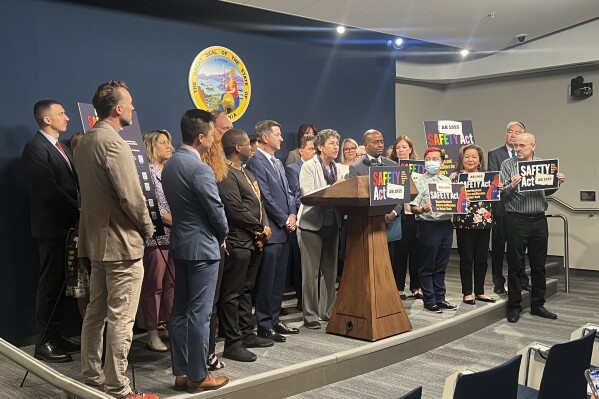California legislators break with Gov. Newsom over loan to keep state’s last nuclear plant running
LOS ANGELES (AP) — The California Legislature signaled its intent on Thursday to cancel a $400 million loan payment to help finance a longer lifespan for the state’s last nuclear power plant, exposing a rift with Gov. Gavin Newsom who says that the power is critical to safeguarding energy supplies amid a warming climate.
The votes in the state Senate and Assembly on funding for the twin-domed Diablo Canyon plant represented an interim step as Newsom and legislative leaders, all Democrats, continue to negotiate a new budget. But it sets up a public friction point involving one of the governor’s signature proposals, which he has championed alongside the state’s rapid push toward solar, wind and other renewable sources.
The dispute unfolded in Sacramento as environmentalists and antinuclear activists warned that the estimated price tag for keeping the seaside reactors running beyond a planned closing by 2025 had ballooned to nearly $12 billion, roughly doubling earlier projections. That also has raised the prospect of higher fees for ratepayers.
Operator Pacific Gas & Electric called those figures inaccurate and inflated by billions of dollars.



H.D. Palmer, a spokesperson for the California Department of Finance, emphasized that budget negotiations are continuing and the legislative votes represented an “agreement between the Senate and the Assembly — not an agreement with the governor.”
The votes in the Legislature mark the latest development in a decades-long fight over the operation and safety of the plant, which sits on a bluff above the Pacific Ocean midway between Los Angeles and San Francisco.
Diablo Canyon, which began operating in the mid-1980s, produces up to 9% of the state’s electricity on any given day.
The fight over the reactors’ future is playing out as the long-struggling U.S. nuclear industry sees a potential rebirth in the era of global warming. Nuclear power doesn’t produce carbon pollution like fossil fuels, but it leaves behind waste that can remain dangerously radioactive for centuries.
A Georgia utility just finished the first two scratch-built American reactors in a generation at a cost of nearly $35 billion. The price tag for the expansion of Plant Vogtle from two of the traditional large reactors to four includes $11 billion in cost overruns. In Wyoming, Bill Gates and his energy company have started construction on a next-generation nuclear power plant that the tech titan believes will “revolutionize” how power is generated.
In 2016, PG&E, environmental groups and plant worker unions reached an agreement to close Diablo Canyon by 2025. But the Legislature voided the deal in 2022 at the urging of Newsom, who said the power is needed to ward off blackouts as a changing climate stresses the energy system. That agreement for a longer run included a $1.4 billion forgivable state loan for PG&E, to be paid in several installments.
California energy regulators voted in December to extend the plant’s operating run for five years, to 2030.
The legislators’ concerns were laid out in an exchange of letters with the Newsom administration, at a time when the state is trying to close an estimated $45 billion deficit. Among other concerns, they questioned if, and when, the state would be repaid by PG&E, and whether taxpayers could be out hundreds of millions of dollars if the proposed extension for Diablo Canyon falls through.
Construction at Diablo Canyon began in the 1960s. Critics say potential earthquakes from nearby faults not known to exist when the design was approved could damage equipment and release radiation. One fault was not discovered until 2008. PG&E has long said the plant is safe, an assessment the NRC has supported.
Last year, environmental groups called on federal regulators to immediately shut down one of two reactors at the site until tests can be conducted on critical machinery they believe could fail and cause a catastrophe. Weeks later, the Nuclear Regulatory Commission took no action on the request and instead asked agency staff to review it.
The questions raised by environmentalists about the potential for soaring costs stemmed from a review of state regulatory filings submitted by PG&E, they said. Initial estimates of about $5 billion to extend the life of the plant later rose to over $8 billion, then nearly $12 billion, they said.
“It’s really quite shocking,” said attorney John Geesman, a former California Energy Commission member who represents the Alliance for Nuclear Responsibility, an advocacy group that opposes federal license renewals in California. The alliance told the state Public Utilities Commission in May that the cost would represent “by far the largest financial commitment to a single energy project the commission has ever been asked to endorse.”
PG&E spokesperson Suzanne Hosn said the figures incorrectly included billions of dollars of costs unrelated to extending operations at the plant.
The company has pegged the cost at $8.3 billion, Hosn said, adding that “the financial benefits exceed the costs.”
Disclaimer: The copyright of this article belongs to the original author. Reposting this article is solely for the purpose of information dissemination and does not constitute any investment advice. If there is any infringement, please contact us immediately. We will make corrections or deletions as necessary. Thank you.





